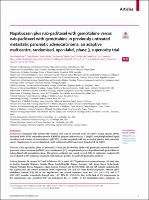Napabucasin plus nab-paclitaxel with gemcitabine versus nab-paclitaxel with gemcitabine in previously untreated metastatic pancreatic adenocarcinoma: an adaptive multicentre, randomised, open-label, phase 3, superiority trial

View
Author
Date
2023-04Permanent link
https://hdl.handle.net/11351/9288DOI
10.1016/j.eclinm.2023.101897
ISSN
2589-5370
PMID
36969338
Abstract
Background
Compared with normal cells, tumour cells contain elevated levels of reactive oxygen species (ROS). Increased levels of the antioxidant protein NAD(P)H:quinone oxidoreductase 1 (NQO1) and phosphorylated signal transducer and activator of transcription 3 (pSTAT3) correlate negatively with the survival of patients with pancreatic cancer. Napabucasin is an investigational, orally administered ROS generator bioactivated by NQO1.
Methods
In the open-label, phase 3 CanStem111P study (NCT02993731), adults with previously untreated metastatic pancreatic adenocarcinoma (mPDAC) were randomised (1:1) to napabucasin plus nab-paclitaxel with gemcitabine or nab-paclitaxel with gemcitabine alone. The primary endpoint was overall survival (OS). In exploratory analyses, OS was evaluated in the subgroup of patients with tumours positive for pSTAT3 (biomarker-positive).
Findings
Between 30 January 2017 and 20 February 2019, a total of 1779 patients were screened across 165 study sites in Austria, Australia, Belgium, Canada, China, Czech Republic, France, Germany, Italy, Japan, Korea, Netherlands, Poland, Portugal, Russia, Singapore, Spain, Taiwan, Ukraine, and the US. Of the 565 and 569 patients randomised to the napabucasin and control treatment arms, respectively, 206 and 176 were biomarker-positive. Median (95% confidence interval [CI]) OS in the napabucasin and control treatment arms was 11.4 (10.5–12.2) and 11.7 (10.7–12.7) months, respectively (hazard ratio, 1.07; 95% CI, 0.93–1.23). Due to the lack of OS improvement in the napabucasin arm, CanStem111P was terminated due to futility. In the biomarker-positive subgroup, no difference between treatment arms was found for OS. Grade ≥3 adverse events were reported in 85.4% and 83.9% of napabucasin-treated and control-treated patients, respectively. The incidence of gastrointestinal-related grade ≥3 events was higher with napabucasin (diarrhoea: 11.6% vs 4.9%; abdominal pain: 10.0% vs 4.8%).
Interpretation
Our findings suggested that although the addition of napabucasin to nab-paclitaxel with gemcitabine did not improve efficacy in patients with previously untreated mPDAC, the safety profile of napabucasin was consistent with previous reports. CanStem111P represents the largest cohort of patients with mPDAC administered nab-paclitaxel with gemcitabine in the clinical trial setting. Our data reinforce the value of nab-paclitaxel plus gemcitabine as a platform for novel therapeutics approaches in mPDAC.
Keywords
Adenocarcinoma; Napabucasin; Pancreatic cancerBibliographic citation
Bekaii-Saab T, Okusaka T, Goldstein D, Oh DY, Ueno M, Ioka T, et al. Napabucasin plus nab-paclitaxel with gemcitabine versus nab-paclitaxel with gemcitabine in previously untreated metastatic pancreatic adenocarcinoma: an adaptive multicentre, randomised, open-label, phase 3, superiority trial. eClinicalMedicine. 2023 Apr;58:101897.
Audience
Professionals
This item appears in following collections
- HVH - Articles científics [4471]
- VHIO - Articles científics [1250]
The following license files are associated with this item:

 Private area
Private area Contact Us
Contact Us







